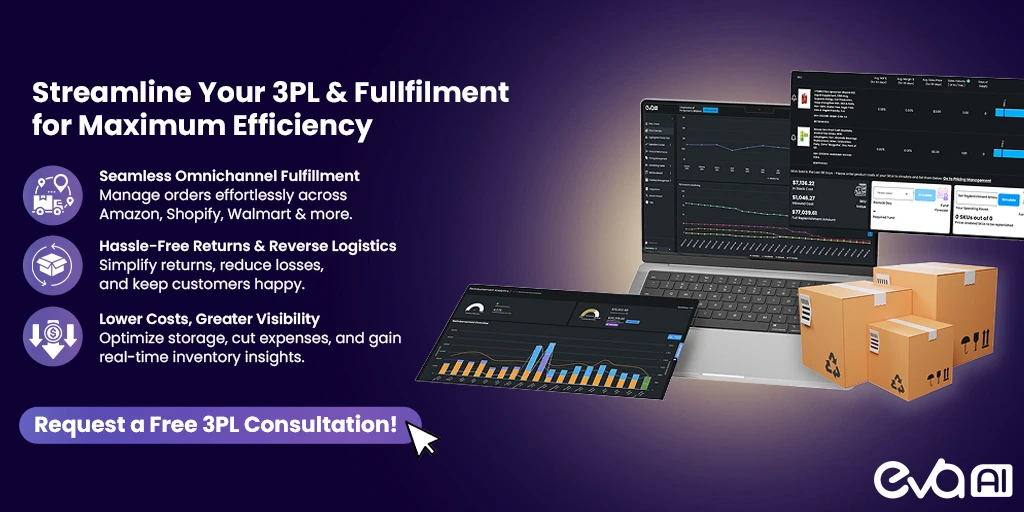Table of Contents
- Introduction
- What is Amazon Inventory Management?
- How Amazon FBA Inventory Management Works
- Step-by-Step Breakdown of FBA Inventory Management
- Understanding Inventory Performance Metrics
- Tips for Efficient Amazon Inventory Management
- Amazon Inventory Management Best Practices
- Understanding FBA Capacity Limits
- How Data-Driven Decisions Can Improve Inventory Management
- How Eva Can Help?
- Conclusion
- FAQs
Introduction
Amazon Inventory Management is critical for sellers looking to thrive in today’s fast-paced marketplace.
With millions of products competing for visibility, sellers need a system that keeps track of inventory and integrates seamlessly with their overall business strategy.
A robust inventory management system allows sellers to anticipate demand, avoid stockouts, and minimize excess stock—saving money while increasing profitability.
Mastering Amazon Inventory Management means more than just watching product levels.
It requires predictive analytics, robust planning, and automation to ensure your brand meets customer demand without overstretching resources.
In this blog, we will explore the best practices, challenges, and strategies for optimizing inventory on Amazon.
We’ll also explain how Eva’s AI-powered platform, with its unique advantages, can relieve you from manual inventory management, allowing you to make data-driven decisions and optimize profitability across multiple marketplaces easily.
What is Amazon Inventory Management?
Amazon Inventory Management systematically tracks, replenishes, and optimizes Amazon product stock.
Proper inventory management ensures the correct quantity of products is available when needed, minimizing the risk of running out of stock or overstocking, which can harm profitability.
The Basics of Inventory Management for Amazon Sellers
Inventory management is a crucial component of running a successful Amazon business.
It involves keeping track of products, forecasting demand, and ensuring timely restocks to avoid issues like stockouts or excess storage fees.
Amazon sellers need to implement a robust system to handle multiple aspects of their inventory, including supplier coordination, sales data analysis, and order fulfillment.
By taking a proactive approach to these tasks, sellers can stay ahead of demand and avoid reactive measures.
Why Inventory Management is Crucial for Amazon Businesses
Amazon is a competitive marketplace, and inventory management directly affects your business’s ability to scale.
Effective management reduces costs and improves customer satisfaction by ensuring prompt delivery and consistent stock availability.
Optimized inventory leads to better seller metrics, improved search rankings, and access to programs like Amazon Prime.
How Amazon FBA Inventory Management Works
Fulfillment by Amazon (FBA) simplifies inventory management by handling storage, shipping, and customer service.
However, understanding how to navigate the system efficiently is critical to maximizing profitability.
Step-by-Step Breakdown of FBA Inventory Management
Listing and Storing Products
When you send inventory to an Amazon fulfillment center, the first step is creating a product listing with accurate details.
Amazon stores your products and handles storage logistics, but monitoring fees and ensuring your products are categorized correctly is essential to avoid issues later.
Tracking Inventory
Amazon provides real-time inventory tracking through Seller Central. You can monitor stock levels, sales velocity, and reorder points, ensuring you never unexpectedly run out of stock.
Replenishing Stock
Replenishment requires anticipating demand accurately to avoid stockouts while minimizing overstocking.
FBA offers automated tools that alert you when it’s time to restock, helping maintain an optimal inventory balance.
Fulfilling Orders
When a customer orders, Amazon’s fulfillment centers handle the packaging and shipping process. This automation reduces the burden on sellers, allowing them to focus on other aspects of their business.
Monitoring Inventory Health
Amazon offers tools like the Inventory Health Report, which provides insights into stranded inventory, sell-through rates, and excess stock.
Regularly monitoring these reports helps sellers proactively keep their inventory healthy.
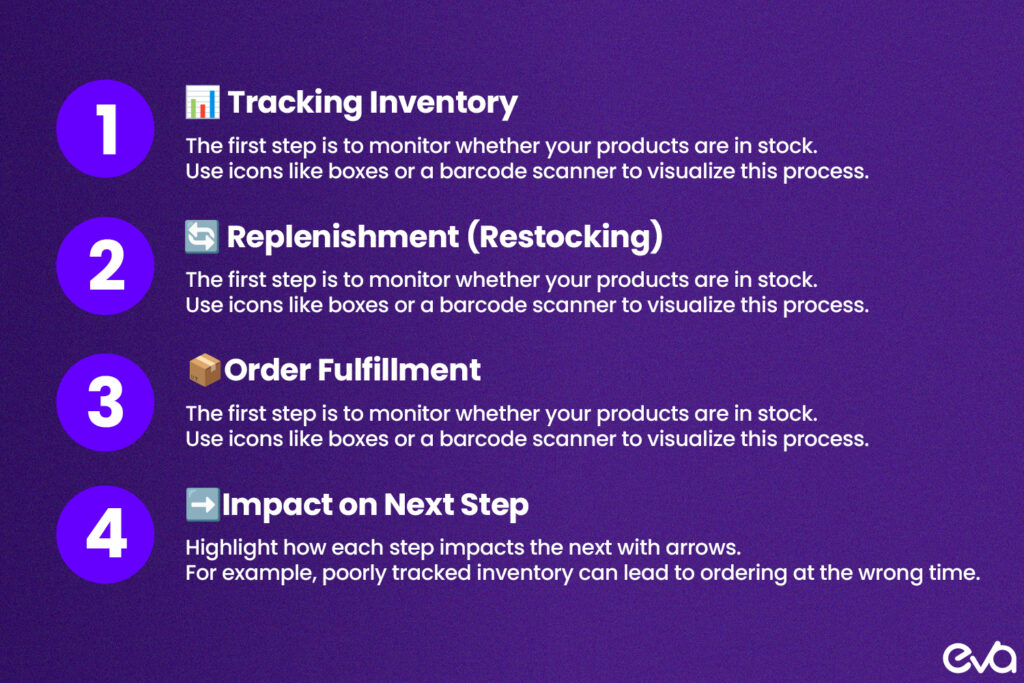
Understanding Inventory Performance Metrics
Amazon’s Inventory Performance Index (IPI) is one of the key metrics for sellers. It tracks inventory health based on factors like excess inventory, stock levels, and sell-through rates.
Understanding and actively managing your IPI score can grant you benefits such as increased storage limits, while a low score can restrict access to premium services.
This knowledge empowers sellers to make informed decisions and take proactive steps to optimize their inventory performance.
Common Inventory Management Challenges on Amazon
Even with FBA, sellers need help managing inventory effectively. Identifying these issues early helps prevent costly mistakes.
Running Out of Stock: Causes and Solutions
Stockouts are a nightmare for sellers. They can occur due to poor demand forecasting, supplier delays, or increased sales during promotions.
To avoid this, sellers should set reorder points and use historical sales data to plan.
Overstocking Issues and How to Avoid Them
Overstocking ties up capital and incurs storage fees. Avoid overstocking by closely monitoring demand trends and using tools that predict the optimal amount of inventory to hold at any given time.
Dealing with Stranded Inventory
Stranded inventory refers to products unavailable for purchase due to listing errors or policy violations.
Regularly auditing listings and using Amazon’s Stranded Inventory Tool can help quickly resolve these issues.
Aged Inventory Surcharge: What You Need to Know
Amazon charges fees for inventory in fulfillment centers that is stored for more than 365 days. Sellers must monitor aging stock closely and take action to avoid long-term storage fees, either by running promotions or liquidating products.
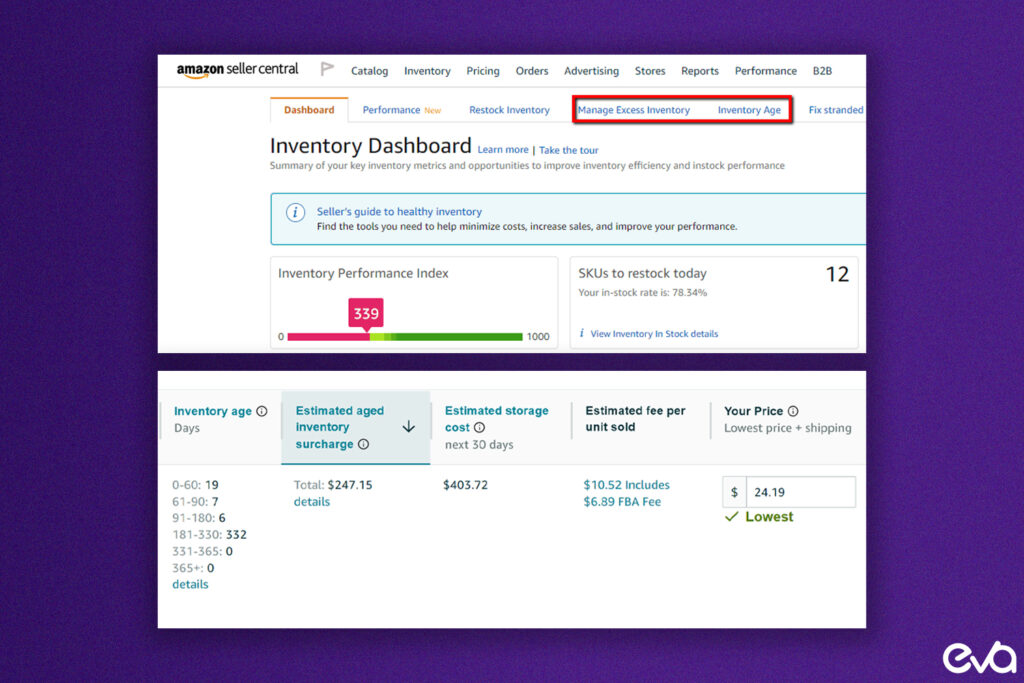
Tips for Efficient Amazon Inventory Management
Forecast Demand Accurately
Accurate demand forecasting prevents stockouts and overstocking. To anticipate future demand, use historical sales data and consider factors like seasonality, upcoming promotions, and market trends.
Set Safety Stock Levels
Safety stock acts as a buffer in case of supply chain disruptions or sudden sales surges. Sellers can ensure they’re covered by calculating optimal safety stock levels without tying up too much capital.
Optimize Lead Time
Lead time is the time between placing an order with a supplier and receiving it. Optimizing this ensures your products are replenished before stock runs out but without holding excess stock. Coordinate closely with suppliers to shorten lead times.
Manage Excess Inventory Effectively
If you have excess inventory, consider running promotions or bundling products to move them faster. You can also explore Amazon’s liquidation options to avoid long-term storage fees.
Automate Replenishment to Stay Ahead
Inventory management tools offer automated replenishment features, which trigger orders when stock levels dip below a certain threshold. Automating this process helps ensure you’re always ahead of demand.
Amazon Inventory Management Best Practices
How to Avoid Inventory Stockouts
To prevent stockouts, monitor sales velocity and set up alerts when stock levels drop below a predefined threshold.
Regular inventory audits and demand forecasting can help ensure you always have enough stock to meet customer demand.
Backup Fulfillment Plans for Inventory Shortages
It’s essential to have backup plans in place for when stockouts occur. Diversify your fulfillment channels by integrating other marketplaces like Walmart or eBay, or consider using third-party fulfillment services as an alternative to FBA.
Handling Returns and Refunds Efficiently
Efficiently managing returns and refunds is critical to maintaining customer satisfaction. Amazon offers automated return processes through Seller Central, but having a plan for processing returns quickly can save time and improve customer loyalty.
Understanding FBA Capacity Limits
Amazon enforces storage limits based on your IPI score. It’s crucial to monitor these limits to avoid exceeding them, which can result in higher fees or restricted selling privileges.
How to View and Manage Your Capacity
You can view your current capacity in Seller Central and detailed reports on how your storage is utilized. Regularly reviewing these reports helps ensure you stay within limits and avoid overages.
Tips for Handling Capacity Restrictions
If your IPI score is low and you face capacity restrictions, focus on improving sell-through rates and reducing excess inventory. Running flash sales or adjusting your product assortment can free up storage space.
Consequences of Exceeding Amazon’s Limits
Exceeding Amazon’s capacity limits can lead to higher fees or even the inability to send in new stock. To avoid this, regularly review your inventory performance and proactively optimize storage.
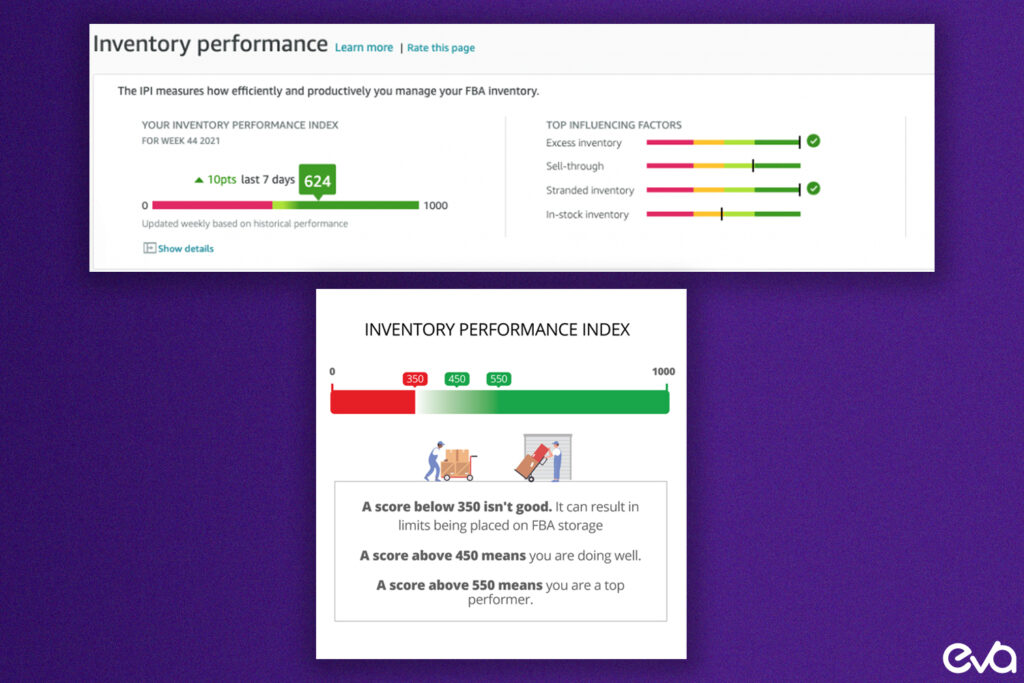
How Data-Driven Decisions Can Improve Inventory Management
Data-driven decision-making is essential to optimizing Amazon’s inventory management. Sellers can make informed decisions that improve efficiency and profitability by using analytics to track sales patterns, storage costs, and demand fluctuations.
Using Inventory Analytics to Optimize Stock Levels
Analyzing your inventory performance using data tools helps you make more accurate decisions about stock levels.
Use historical data, trends, and current sales velocity to fine-tune reorder points and avoid stockouts or overstocking.
Reducing Storage Costs Through Better Forecasting
Data analytics can also help reduce storage costs by improving demand forecasts. By predicting slow periods, you can reduce stock levels and avoid unnecessary storage fees during off-peak times.
Here’s a dashboard-style graphic showing how data analytics can be used to track sales patterns, reorder points, and stock levels. Highlight critical metrics such as IPI score, sell-through rate, and excess inventory.
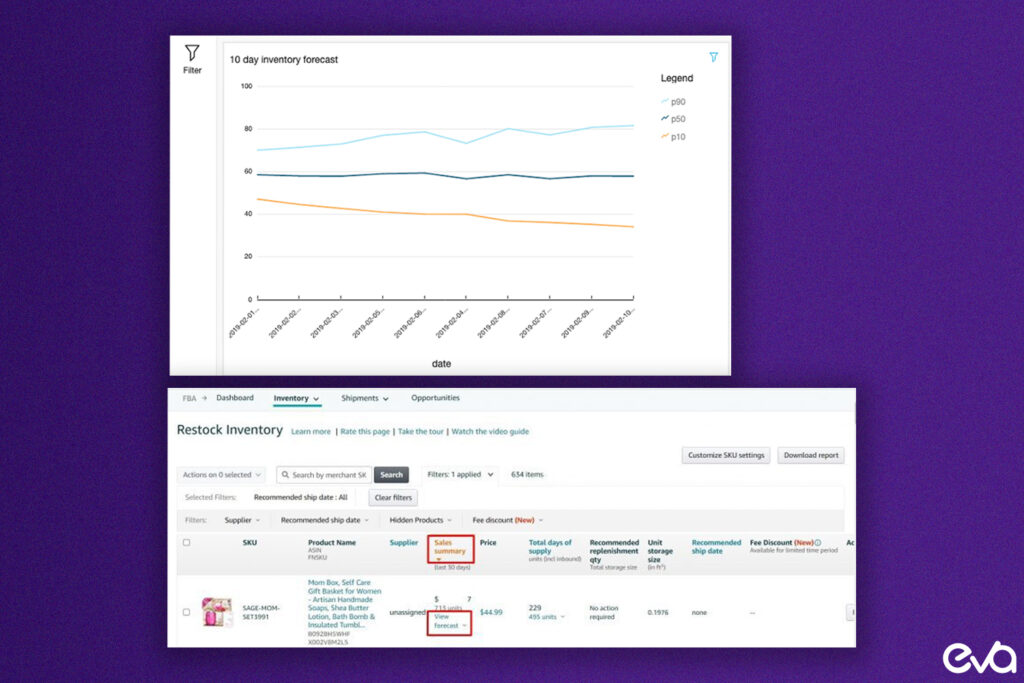
How Eva Can Help?
Eva Commerce is a leading e-commerce technology company uniquely positioned to help brands achieve profitable growth across significant marketplaces like Amazon and Walmart.
Eva’s AI-powered platform goes beyond the basics of inventory tracking and integrates advertising strategies, inventory levels, and profitability metrics across multiple platforms.
This context-aware advertising solution is designed to help sellers make smarter, data-driven decisions that maximize efficiency and return on investment (ROI).
What sets Eva apart is its context-aware AI technology, which seamlessly integrates your advertising campaigns with your inventory management.
The platform automatically analyzes your sales data, inventory levels, and market dynamics to adjust your advertising spend.
By doing so, Eva ensures that your campaigns are both cost-effective and timed perfectly to match stock availability, preventing over-advertising when stock is low and boosting ads when you’re fully stocked.
Eva helps brands focus on data-driven decisions by analyzing vast amounts of information, including:
- Inventory levels: Ensures you never run out of stock during critical ad campaigns.
- Conversion rates: Align advertising spending with real-time sales performance.
- Profitability metrics: Ensures every advertising dollar is spent wisely, with a focus on maximizing profit.
This integrated approach enables brands to scale efficiently, reducing wasteful spending while ensuring high sales velocity.
As an Amazon Advanced Partner and Walmart Strategic Solution Partner, Eva’s AI platform works directly with Amazon and Walmart’s systems to provide unparalleled insights and support.
Eva doesn’t just stop at Amazon and Walmart. We collaborate with industry giants like TikTok, eBay, Shopify, Google, Meta, Wayfair, and Faire, helping brands develop multimedia marketing strategies that drive consistent growth across all platforms.
This holistic approach ensures brands can invest in the most effective mix of advertising channels to reach their target customers and grow sustainably.
By combining inventory management with advertising and profitability metrics, Eva creates a seamless and robust solution for brands looking to optimize their Amazon and multichannel operations.
Eva is more than just an inventory management tool—it’s a comprehensive platform designed to grow your brand profitably.
Whether you need help with inventory forecasting, optimizing advertising spend, or managing stock levels across multiple marketplaces, Eva’s AI-powered system is your partner for long-term success.
Ready to see how Eva can transform your inventory management and boost profitability?Book a free demo today and discover the power of Eva’s AI platform.
Conclusion
Mastering Amazon inventory management is essential for maintaining profitability and scaling your business.
By following the tips and strategies discussed in this guide, sellers can avoid stockouts, minimize excess inventory, and reduce storage fees.
Leveraging tools like Eva’s AI-powered platform can automate processes, provide real-time inventory tracking, and optimize demand forecasting.

FAQs
Eva’s platform integrates real-time stock level data, conversion rate, and profitability metrics, allowing sellers to make smarter, data-driven decisions. The AI automatically adjusts advertising strategies based on current stock, ensuring campaigns run only when inventory is available.
Eva offers real-time inventory tracking, automated replenishment alerts, advanced demand forecasting, and integrated advertising strategies, all of which aim to reduce storage costs, avoid stockouts, and increase profitability.
Eva’s AI monitors inventory levels in real-time and sends alerts when stock levels are low. It also forecasts demand, ensuring timely restocks before products run out.
Eva provides a unified dashboard that tracks inventory across multiple marketplaces, such as Amazon, Walmart, and eBay, ensuring that stock is allocated where it’s needed most.
Eva’s platform is the only context-aware solution that integrates inventory management with advertising strategies and profitability metrics. This holistic approach ensures that every business decision aligns with stock availability and financial goals.
Using AI to align advertising campaigns with stock levels and conversion rates, Eva ensures that sellers invest in advertising when it will drive the most profit. Eva also helps reduce storage fees by optimizing stock levels and preventing excess inventory.
Eva supports Amazon, Walmart, eBay, Shopify, and more, providing a seamless experience managing stock across multiple platforms through a single dashboard.
Eva provides actionable strategies for managing slow-moving inventory, including running promotions, adjusting pricing, or bundling products to move stock faster and reduce long-term storage fees.
Eva’s platform syncs directly with Amazon’s FBA, providing real-time updates on inventory levels and storage fees. This helps sellers optimize their use of FBA for efficient fulfillment and cost management.
Absolutely. Eva’s AI platform is designed to optimize inventory management, streamline operations, and provide data-driven insights, helping sellers scale their business profitably across multiple marketplaces.


